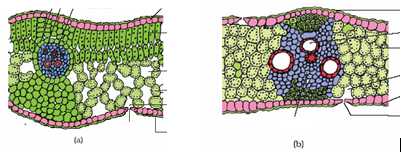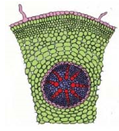Identify the correct statement regarding collenchymas in plants:-
| 1. | They occur in layers below the epidermis of monocotyledonous plants. |
| 2. | Cells are much thickened at the corners due to the deposition of lignin. |
| 3. | Collenchymatous cells do not contain chloroplasts. |
| 4. | They provide mechanical strength to the growing parts of the plant. |
What is the number of correct statements amongst the following regarding the phloem tissue of plants?
| I: | Gymnosperms lack albuminous cells and sieve cells. |
| II: | The companion cells are specialized parenchymatous cells. |
| III: | Phloem parenchyma is absent in most of the monocotyledons. |
| IV: | Phloem fibers are generally absent in the primary phloem. |
1. 0
2. 2
3. 3
4. 4
In dicot roots, the initiation of the lateral roots and the vascular cambium during the secondary growth takes place in:
1. Pericycle
2. Endodermis
3. Conjuctive tissue
4. Epidermis
Bulliform cells:
1. Are found in dorsiventral leaves and help in photosynthesis.
2. Are found in dorsiventral leaves and help in minimizing water loss.
3. Are found in isobilatetral leaves and help in minimizing water loss.
4. Are found in isobilatetral leaves and help in photosynthesis.
During secondary growth in the stem:-
1. The amount of secondary xylem produced is more than the secondary phloem as the
cambium is generally more active on the inner side than the outer.
2. the amount of secondary phloem produced is more than the secondary xylem as the cambium is generally more active on the inner side than the outer.
3. the amount of secondary xylem produced is more than the secondary phloem as the cambium is generally more active on the outer side than the inner.
4. the amount of secondary phloem produced is more than the secondary xylem as the cambium is generally more active on the outer side than the inner.
The term 'bark' includes:
I. Phellogen
II. Phellem
III. Phelloderm
IV. Secondary phloem
1. I, II and III only
2. I, II and IV only
3. II, III and IV only
4. I, II, III and IV only
In the dicot root, the vascular cambium:-
1. is absent
2. is completely secondary in origin
3. does not form a continuous ring
4. originates from the tissue just above the phloem bundles
Cortex is the region found between
(1) Epidermis and stele
(2) Pericycle and endodermis
(3) Endodermis and pith
(4) Endodermis and vascular bundle
The balloon-shaped structures called tyloses
(1) Original in the lumen of vessels
(2) characterise the sapwood
(3) are exetentions of xylem parenchyma cells into vessels
(4) are linked to the ascent of sap through xylem vessels
Interfascicular cambium develops from the cells of ?
1. medullary rays
2. xylem parenchyma
3. endodermis
4. pericycle
Water containing cavities in vascular bundles are found in
1. sunflower
2. maize
3. Cycas
4. Pinus
Which one of the following is not a lateral meristem?
1. Cork cambium
2. Interfascicular cambium
3. Phellogen
4. Intercalary meristem
Palisade parenchyma is absent in leaves of :-
1. Sorghum
2. mustard
3. soybean
4. gram
A common structural feature of vessel elements and sieve tube elements is :-
1. thick secondary walls
2. pores on lateral walls
3. presence of P-protein
4. enucleate condition
Passage cells are found in
1. Dicot stem
2. Monocot root
3. Monocot stem
4. All of these
The quiescent centre in root meristem serves as:-
1. site for storage of food which is utilized during maturation
2. reservoir of growth hormones
3. reserve for replenishment of damaged cells of the meristem
4. region for absorption of water
Cork cambium results in the formation of cork which becomes impermeable to water due to the accumulation of
(1) resins
(2) suberin
(3) lignins
(4) tannins
Axillary bud and terminal are derived from
A. Lateral meristem
B. Intercalary meristem
C. Apical meristem
D. Parenchyma
Plant tissues have been divided into meristematic and permanent tissue based on
1. differentiation capability
2. division capability
3. symmetry
4. plane of division
How many of the following statements are true for meristem-
1. 6
2. 5
3. 4
4. 3
In radial vascular bundle xylem and phloem are present on _____________radii and in
an ___________manner.
1. different and consecutive
2. same and alternate
3. different and alternate
4. same and consecutive
Vascular bundle are ___________and surrounded by ___________ bundle sheath in
monocot stem.
1. scattered, sclerenchymatous
2. arranged, sclerenchymatous
3. scattered, parenchymatous
4. scattered, collenchymatous
Dicot leaves are ____________and monocot leaves are _______________.
(1) hypostomatic and amphistomatic
(2) amphistomatic and hypostomatic
(3) Astomatic and amphistomatic
(4) epistomatic and hypostomatic
Which of the following pairs of cells is related ontogenetically?
1. Trachieds and tracheae
2. Sieve cells and sieve tube components
3. Sieve tube members and phloem
4. Sieve tube members and companion cells
Conjunctive tissue is
1. parenchymatous tissue present between two vascular bundles in dicot stem
2. parenchymatous tissue present between xylem and phloem in root
3. sclerenchymatous tissue present in cortex
4. lateral meristem
Protoxylem and stomata in a dorsiventral leaf are present
1. on the abaxial and adaxial sides, respectively
2. on the adaxial and abaxial sides, respectively
3. on the adaxial side
4. on the abaxial side
Which of the following is not true for companion cells?
1. They are absent in monocots
2. They are parenchymatous
3. They are connected by pits to sieve tube elements
4. They maintain pressure gradient in sieve tubes.
Which of the following do not give commercially important phloem fibers?
1. Jute
2. Cotton
3. Flax
4. Hemp
When the xylem and phloem are situated at the same radius of vascular bundles, the vascular bundle is said to be
1. Open
2. Closed
3. Radial
4. Conjoint
Tissues internal to endodermis comprise the
1. Bark
2. Stele
3. Conjunctive tissue
4. Vascular bundle
Match the column I with column II
Column I Column II
1. a(i), b(ii), c(iii), d(iv)
2. a(iii), b(iv), c(i), d(ii)
3. a(ii), b(iv), c(iii), d(i)
4. a(iii), b(ii), c(i), d(iv)
The cells shown in the below diagram are of ______ tissue and can be seen in ______ layer of the dicot stem.
1. Collenchyma, Hypodermis
2. Sclerenchyma, Sclereids
3. Parenchyma, Pericycle
4. Parenchyma, Pith
Mechanical support to the growing parts of the plant such as young stem and petiole of leaf is provided by a living tissue called
1. Collenchyma
2. Aerenchyma
3. Chlorenchyma
4. Sclerenchyma
Which of the following is correct statement for intercalary meristems?
1. They lie at tip of root apex
2. They lie at base of stem always
3. They are short lived and consumed during primary growth
4. They are long lived and cause increase in length
Compare diagram ‘a’ with ‘b’ and find out which statement is incorrect about difference between these two diagrams.
1. In ‘a’ mesophyll is of two type where as in case of ‘b’ mesophyll is of single type
2. In ‘a’ stomata is mainly at lower surface whereas in ‘b’ stomata is at both the surface
3. In ‘a’ vascular bundle is of different size whereas in ‘b’ vascular bundle is of more or less equal size
4. In ‘a’ xylem is towards adaxial surface whereas in ‘b’ xylem is towards abaxial surface
Parenchyma differs from meristamatic cells is its
1. Cell wall composition
2. Uneven thickenings in cell wall
3. Having cytoplasm and nucleus
4. Larger size, well developed vacuole and peripheral cytosol
Lenticels present in woody trees help in
1. Exchange of gases and transpiration.
2. Exchange of gases and guttation.
3. Only exchange of gases.
4. Elimination of exudates.
The monocot leaves have parallel veination this is reflected in
1. Presence of stomata in the lower epidermis.
2. Conjoint vascular bundles.
3. Nearly similar sizes of vascular bundles.
4. Leaves being isobilateral.
Which of the following is not correctly matched?
1. Companion cell – Albuminous cells in gymnosperm
2. Companion cell – Associated with sieve cells
3. Companion cell – Nucleated structure and its nucleus controls sieve tube
4. Companion cell – Helps in maintaining the pressure gradient in sieve tube
Semilunar patches of sclerenchyma in the dicot stem can be seen
1. Above the phloem.
2. In between the vascular bundles.
3. In the pith.
4. In between phloem and xylem.
The heartwood in trees
1. Is dead but conducts water.
2. Is dead and does not conduct water.
3. Is living and gives mechanical support.
4. Surrounds the sap wood.
The bulliform cells in grasses
1. Are present on the upper epidermis of leaves.
2. Become turgid and cause the leaves to curl inwards under stress.
3. Are small resin filled cells.
4. Help in transpiration.
In monocot roots the vascular bundles are
1. Collateral, endarch and closed.
2. Collateral, exarch and closed.
3. Radial, exarch and open.
4. Radial, exarch and closed.
The diagram below is transverse section of ______ and shows xylem which is ______.
1. Dicot stem, Endarch.
2. Dicot stem, Exarch.
3. Monocot Root, Polyarch.
4. Dicot Root, Endarch.
Which of the following is correct with regard to monocot stem.
1. Monocot stems have a well-developed collenchymatous hypodermis.
2. The vascular bundles are surrounded by a sclerenchymatous bundle sheath.
3. The cortex is differentiated into endodermis and pericycle.
4. The vascular bundles are conjoint and open.